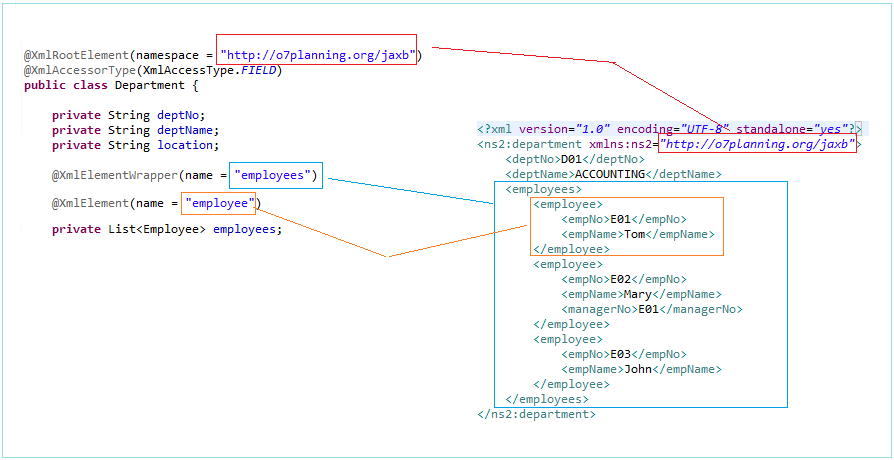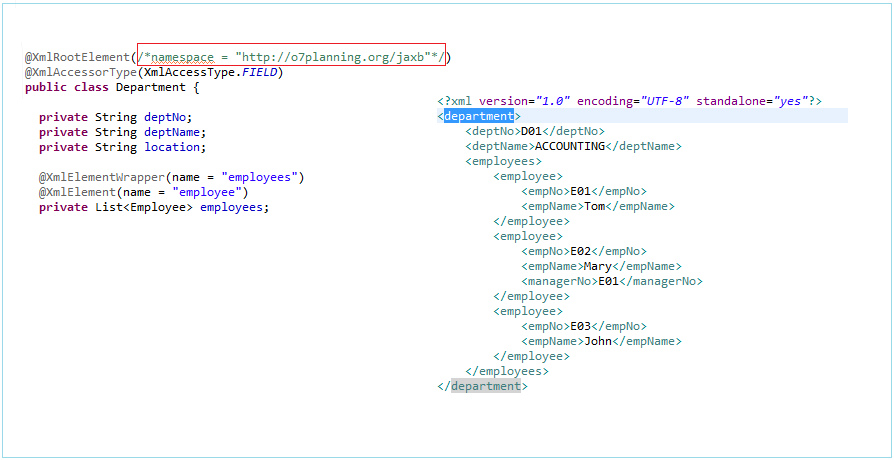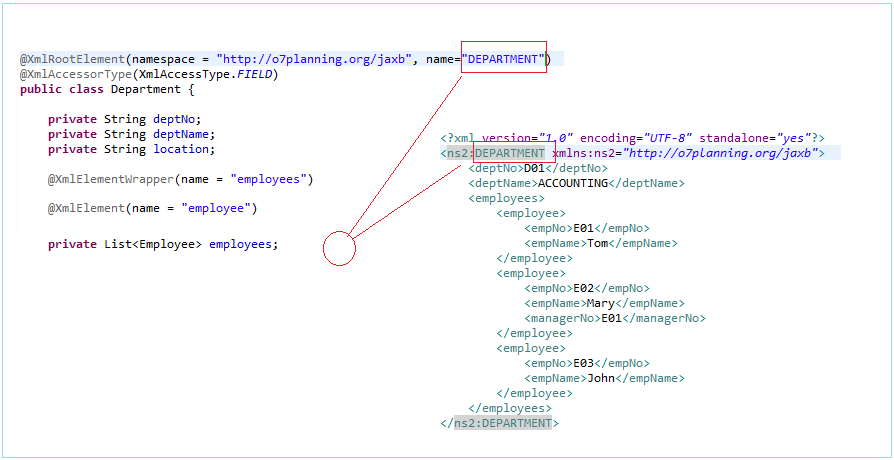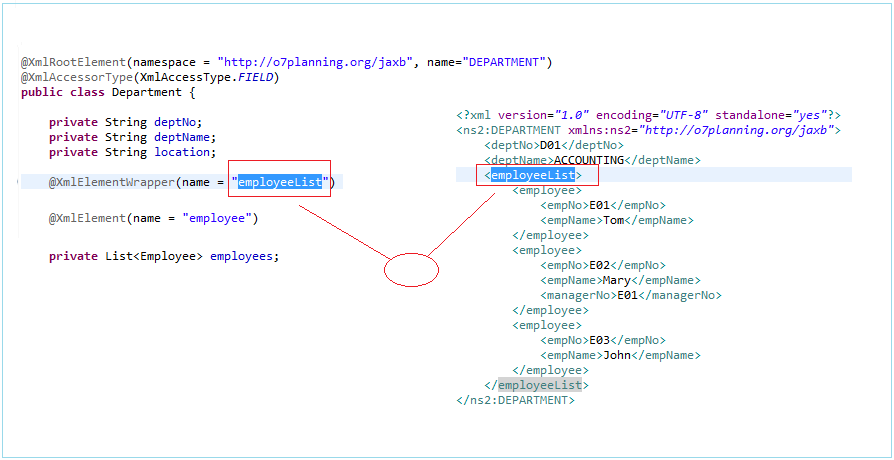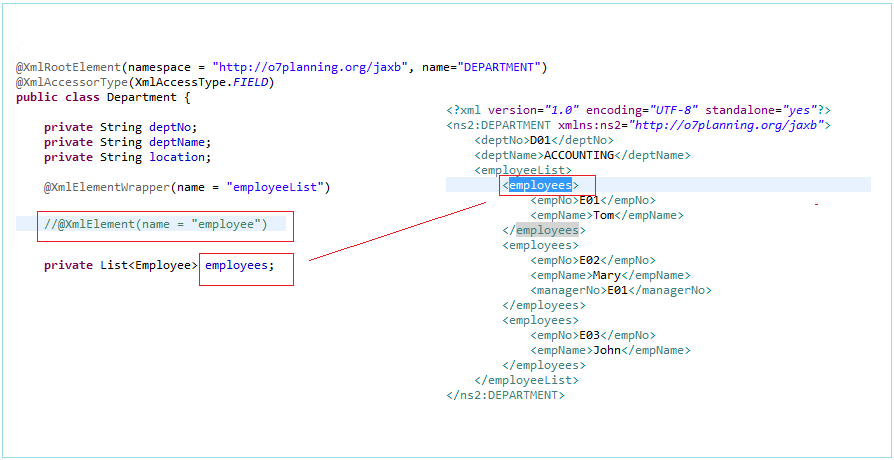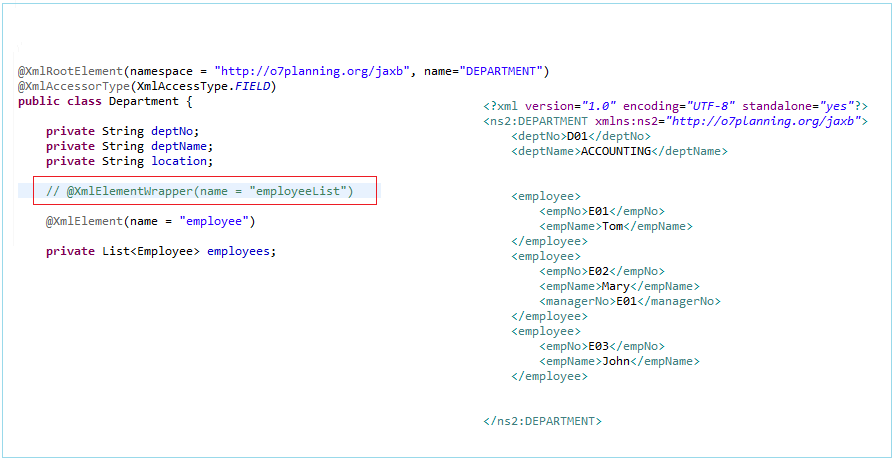Java Architecture for XML Binding (JAXB) Tutorial with Examples
1. Introduction
JAXB is integrated into JDK starting from version 6.0. In case you use the earlier version, you have to download and declare the library to use.
This document based on Java6.
Model of example:
This is the image after project completion.
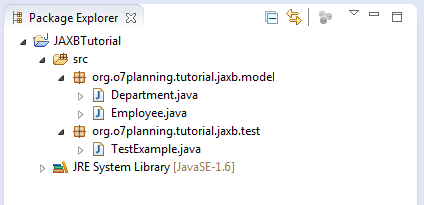
2. Create project
Create a common Java Project
Employee.java
package org.o7planning.tutorial.jaxb.model;
import javax.xml.bind.annotation.XmlAccessType;
import javax.xml.bind.annotation.XmlAccessorType;
import javax.xml.bind.annotation.XmlRootElement;
@XmlRootElement(name = "employee")
@XmlAccessorType(XmlAccessType.FIELD)
public class Employee {
private String empNo;
private String empName;
private String managerNo;
/**
* This default constructor is required if there are other constructors.
*/
public Employee() {
}
public Employee(String empNo, String empName, String managerNo) {
this.empNo = empNo;
this.empName = empName;
this.managerNo = managerNo;
}
public String getEmpNo() {
return empNo;
}
public void setEmpNo(String empNo) {
this.empNo = empNo;
}
public String getEmpName() {
return empName;
}
public void setEmpName(String empName) {
this.empName = empName;
}
public String getManagerNo() {
return managerNo;
}
public void setManager(String managerNo) {
this.managerNo = managerNo;
}
}
Department.java
package org.o7planning.tutorial.jaxb.model;
import java.util.List;
import javax.xml.bind.annotation.XmlAccessType;
import javax.xml.bind.annotation.XmlAccessorType;
import javax.xml.bind.annotation.XmlElement;
import javax.xml.bind.annotation.XmlElementWrapper;
import javax.xml.bind.annotation.XmlRootElement;
@XmlRootElement(namespace = "http://o7planning.org/jaxb")
@XmlAccessorType(XmlAccessType.FIELD)
public class Department {
private String deptNo;
private String deptName;
private String location;
@XmlElementWrapper(name = "employees")
@XmlElement(name = "employee")
private List<Employee> employees;
/**
* This default constructor is required if there are other constructors.
*/
public Department() {
}
public Department(String deptNo, String deptName, String location) {
this.deptNo = deptNo;
this.deptName = deptName;
}
public String getDeptNo() {
return deptNo;
}
public void setDeptNo(String deptNo) {
this.deptNo = deptNo;
}
public String getDeptName() {
return deptName;
}
public void setDeptName(String deptName) {
this.deptName = deptName;
}
public String getLocation() {
return location;
}
public void setLocation(String location) {
this.location = location;
}
public List<Employee> getEmployees() {
return employees;
}
public void setEmployees(List<Employee> employees) {
this.employees = employees;
}
}TestExample.java
package org.o7planning.tutorial.jaxb.test;
import java.io.File;
import java.io.FileReader;
import java.util.ArrayList;
import java.util.List;
import javax.xml.bind.JAXBContext;
import javax.xml.bind.Marshaller;
import javax.xml.bind.Unmarshaller;
import org.o7planning.tutorial.jaxb.model.Department;
import org.o7planning.tutorial.jaxb.model.Employee;
public class TestExample {
private static final String XML_FILE = "dept-info.xml";
public static void main(String[] args) {
Employee emp1 = new Employee("E01", "Tom", null);
Employee emp2 = new Employee("E02", "Mary", "E01");
Employee emp3 = new Employee("E03", "John", null);
List<Employee> list = new ArrayList<Employee>();
list.add(emp1);
list.add(emp2);
list.add(emp3);
Department dept = new Department("D01", "ACCOUNTING", "NEW YORK");
//
dept.setEmployees(list);
try {
// create JAXB context and instantiate marshaller
JAXBContext context = JAXBContext.newInstance(Department.class);
// (1) Marshaller : Java Object to XML content.
Marshaller m = context.createMarshaller();
m.setProperty(Marshaller.JAXB_FORMATTED_OUTPUT, Boolean.TRUE);
// Write to System.out
m.marshal(dept, System.out);
// Write to File
File outFile = new File(XML_FILE);
m.marshal(dept, outFile);
System.err.println("Write to file: " + outFile.getAbsolutePath());
// (2) Unmarshaller : Read XML content to Java Object.
Unmarshaller um = context.createUnmarshaller();
// XML file create before.
Department deptFromFile = (Department) um.unmarshal(new FileReader(
XML_FILE));
List<Employee> emps = deptFromFile.getEmployees();
for (Employee emp : emps) {
System.out.println("Employee: " + emp.getEmpName());
}
} catch (Exception e) {
e.printStackTrace();
}
}
}
Results when running class TestExample :
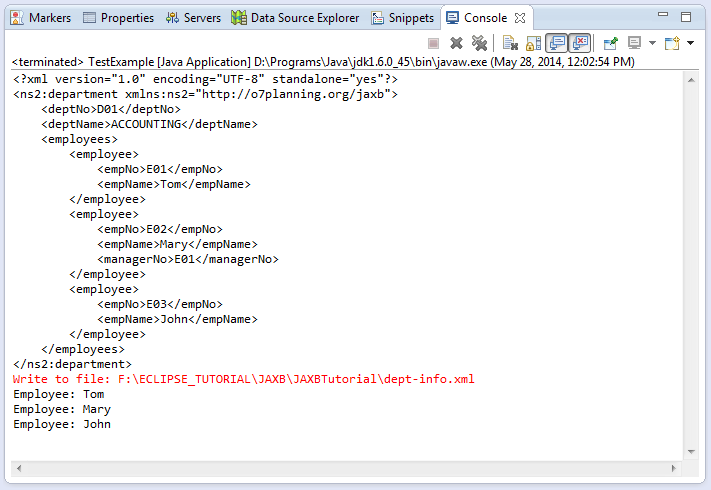
Way JAXB mapping Java and XML:
